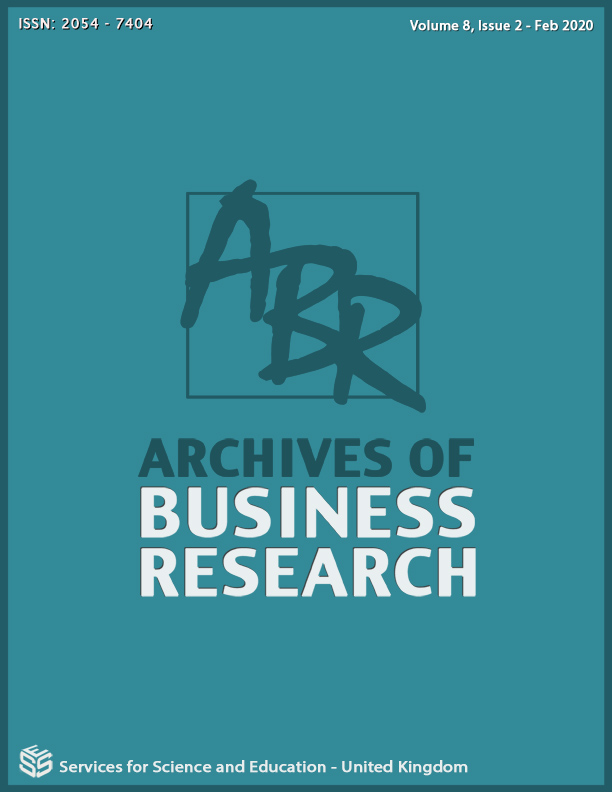C. Pareto's Rule 80/20 Pareto’s Rule on global wealth and material distribution: The role of start-ups to change the dynamics of the rule
DOI:
https://doi.org/10.14738/abr.82.7843Keywords:
Pareto rule, wealth distribution, start-up, dynamics, vital few and trivial manyAbstract
Pareto Rule of 80/20 has a lot to inform the globe of the inequalities that prevail in human and business systems. This Rule of 80/20 was first postulated by Juran in 1937, however the principles are still applicable in the modern society. It is so unfortunate that the 20% who controls 80% (vital few) of the global wealth, is still sustained. The 80% who controls only 20% (trivial many) of the global income still find themselves constricted to that position. This is a pathetic situation, and governments should do well to help start-ups and the marginalised in societies to extricate themselves from this mess. Poverty or unfair distribution of wealth should not be accepted as the order of life, and individuals should do well to come out of it. It is the hope of this article that when start-ups are given the necessary push by government to be sustainable, there would be a paradigm shift within the 80/20 Rule of Pareto
References
https://www.bbc.com/news/av/world-asia-india-45091665/India-floods-.....
BBC (2nd Dec. 2019b). Why is there a backlash against climate policies?
Retrieved from:
https://www.bbc.co.uk/programmes/w3csth0.
Brookes, C. H. P., Grouse, P. J., Jeffery, D. R., & Lawrence, M. J. (1982). Information systems design. Australia: Prentice-Hall.
Cales, A. (10th Jan. 2020). The devastation of Australia’s wildfires. Retrieved from https://farragutanchor.org/8298/features/the-devastation-of-australias-wildfires/
CNN (5th Dec. 2019). How AI is helping spot wildfires faster. Retrieved from:
https://edition.cnn.com/2019/12/05/tech/ai-wildfires/index.html.
Daly, H. (2008). Ecological economics and sustainable development: Selected Essays. NY, USA: Edward Elgar.
Dessler, G. (2004). Management-principles and practices for tomorrow’s leaders (3rd edition). USA: Prentice Hall Inc.
De Wit, B., & Meyer, R. (2004). Strategy: Process, content and context (3rd edition). Italy: Thomson Learning.
Gaines, C., Hoover, D., Foxx, W., Matuszek, T., & Morrison, R. (2012). Information systems as a strategic partner in organizational performance. Journal of Management and Market Research, 10(1), May 2012. ISSN: 1941-3408.
Graham, A. (1998). The vital few, the trivial many. Internal Auditor, 55(6), Dec. 1998.
ISSN: 00205745.
Hammer, M. (1990). Reengineering Work: Don’t automate, obliterate, Harvard Business Review, July-August 1990, pp.104-111.
Hitt, Black, & Porter (2004). Management (1st edition). eBook. USA: Hall Inc.
Hornby, A. S. (2001). Oxford advanced learner’s dictionary (6th edition). Oxford: Oxford University Press.
Institute of Information Technology (1996). Infotec. Accra: IIT.
Jiang, J., Klein, G., & Balloun, J. (1996). Ranking of system implementation success factors, Project Management Journal, 27 (4). pp. 50-55.
Klein, G. P. (1999). Entrepreneurship and corporate governance. The Quarterly Journal of Austrian Economics. 2 (2), Summer 1999.
Kwadade-Cudjoe, F. (2015). Sustaining Corporate Growth: Exploring the role of MIS in monitoring Companies’ Performance. Saarbrucken, GE: Lambert Academic Publishing. ISBN: 978-3-659-80638-4.
Mustapha, S. (Aug. 2012). Midland savings to increase support to SMEs. The Ghanaian Times, ISD 4/7/90.
Nowduri, S. (2011). Management information systems and business decision making: review, analysis and recommendations, Journal of Management and Market Research, 7(9). April 2011, ISSN: 1941 - 3408.
Nugent, J. H. (2003). Plan to win: Analytical and operational tools-Gaining competitive advantage. USA: McGraw Hill.
OECD (2004). OECD Principles of corporate governance. ISBN: 92-64-01597-3 – No. 53533 2004.
Peng, M. W., Wang, D. W., & Jiang, Y. (2008). An institution-based view of international business strategy: a focus on emerging economies, Journal of International Business Studies, 2000.
Rich, S. R., & Gumpert, D. E. (1985). How to write a winning business plan. Harvard
Business Review, May, 1985.
Rothkopf, D. (2008). The 20/80 Rule. Video, stanford’s technology ventures program.
(28 February, 2011).
Sahlman, W. A. (1997). How to write a great business plan, Harvard Business Review.
July-August 1997.
Sam, S. (2012, November 12). Government to use part of oil revenue to grow SMEs. The Ghanaian Times, ISD 4/7/90.
Santoro, G. (2012). Entrepreneurship (1st edition). Delhi: University Publications.
ISBN: 978-81-323-3994-6.
Sobel, R. S. (2012). Entrepreneurship. Retrieved from
https://www.econlib.org/library/Enc/Entrepreneurship.html.
Spinner, M. P. (1992). Elements of project management: Plan, schedule and control.
Englewood Cliffs: Prentice-Hall.
Thompson, A. A. Jr., & Strickland, A. J. III (2001). Crafting and executing strategy (12th edition). NY: McGraw-Hill.
Ward, J. (1995). Project Pitfall, Information system management, 12(1). pp. 74-76.
White, C. (2004). Strategic management, New York: Palgrave Macmillan.
ISBN: 9781403904003.






